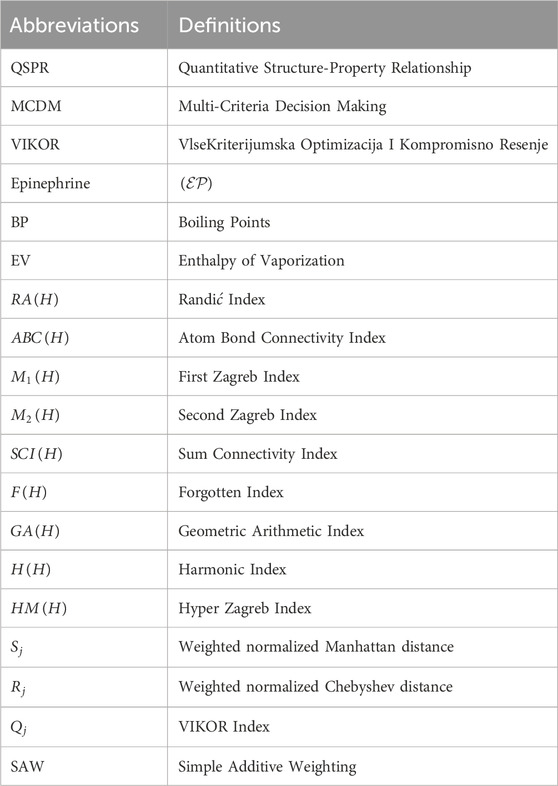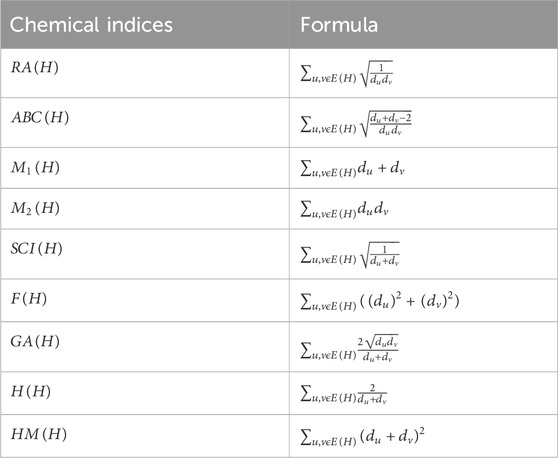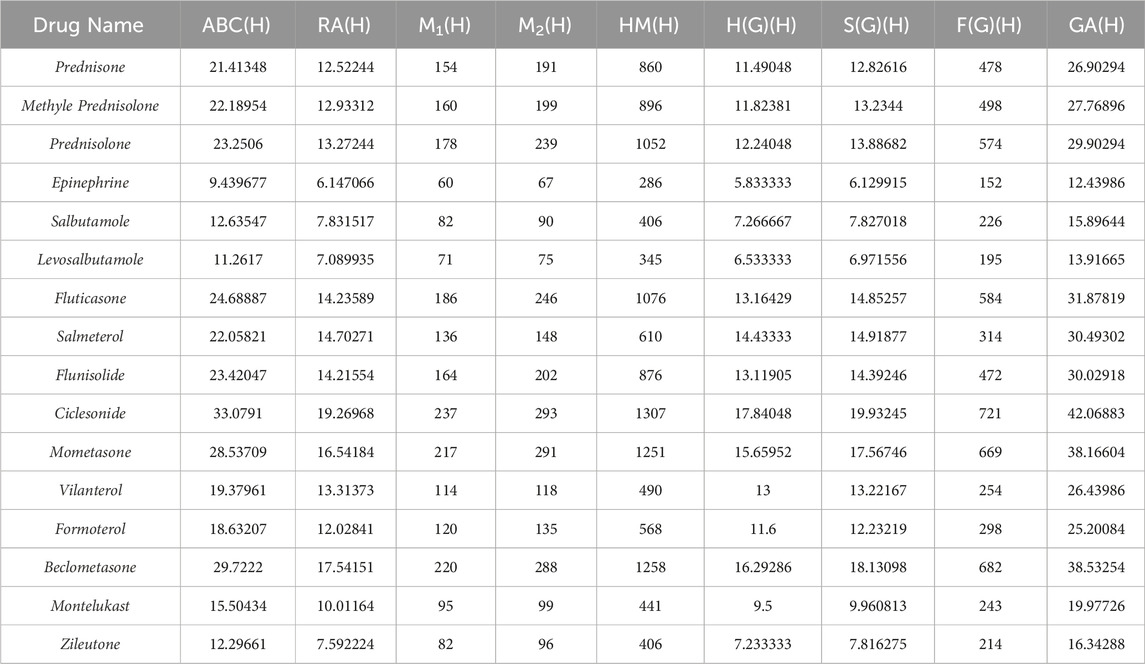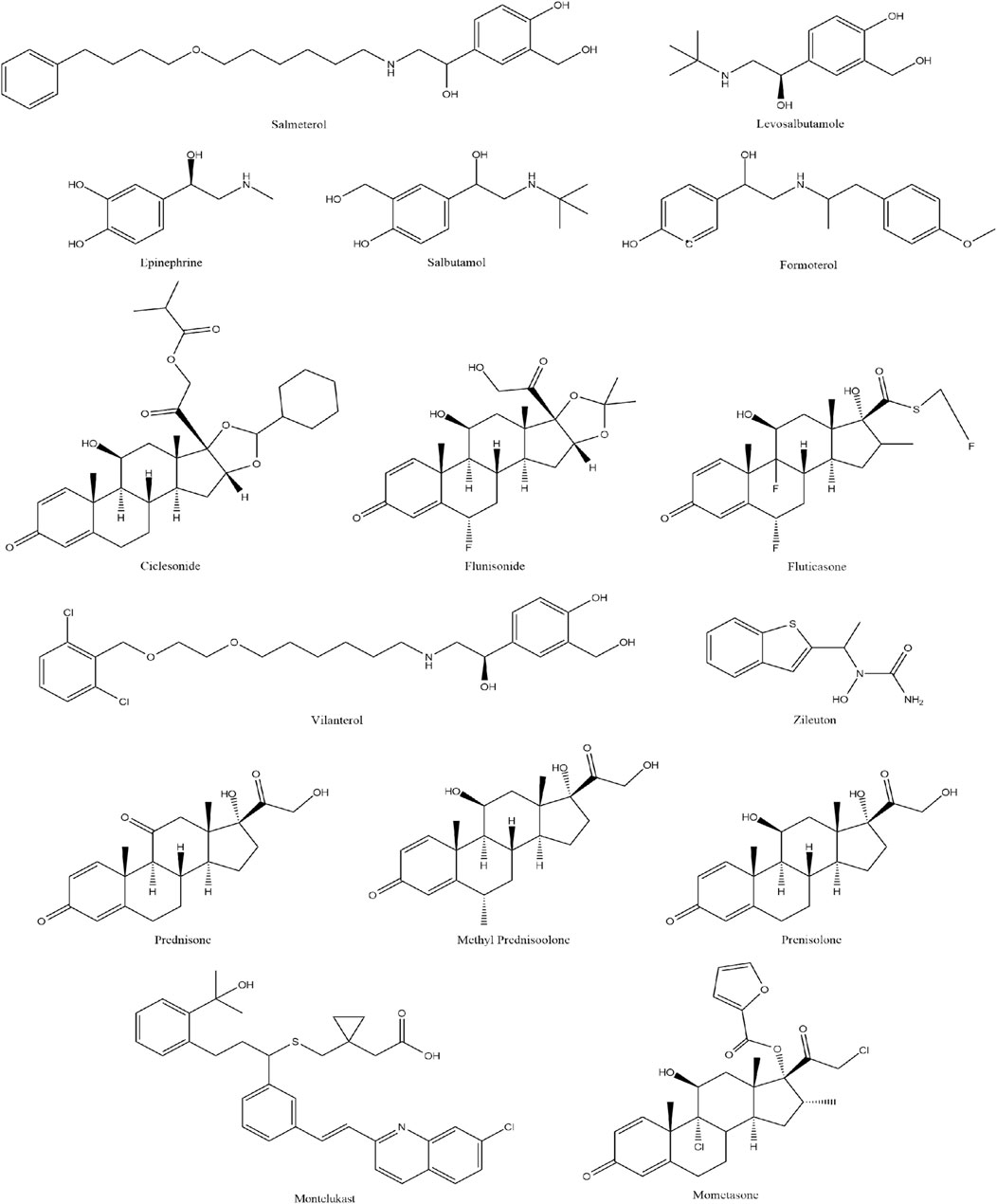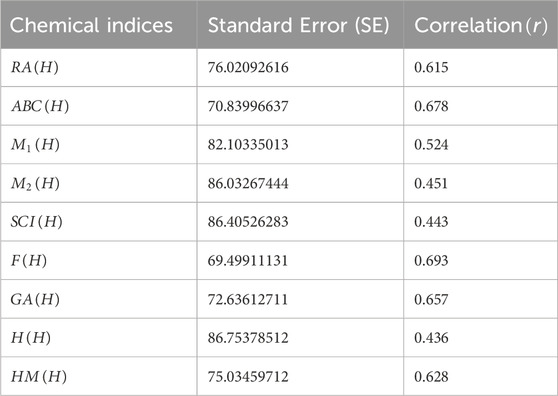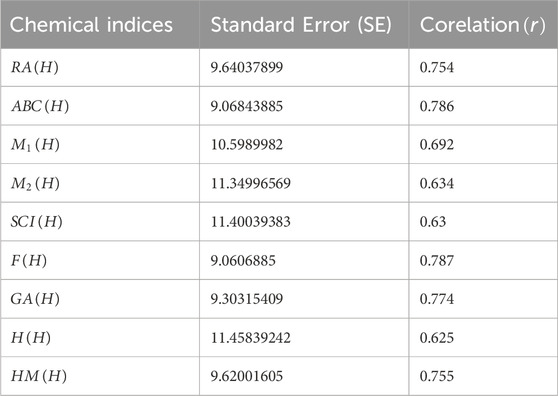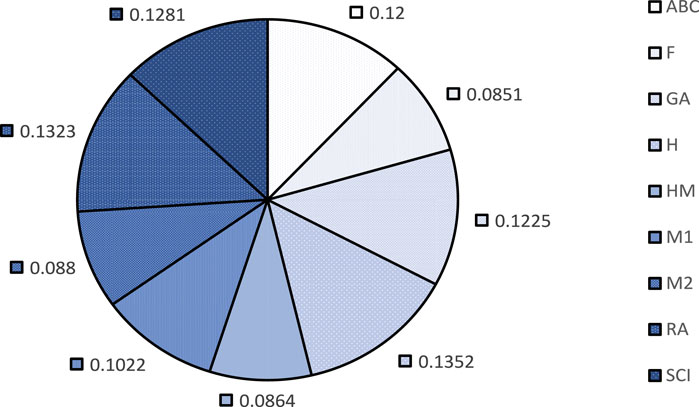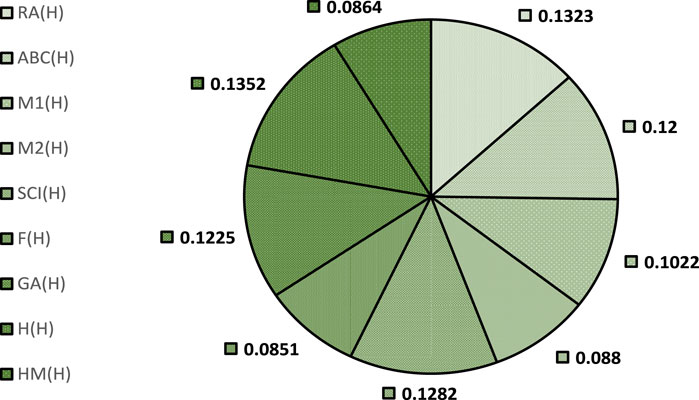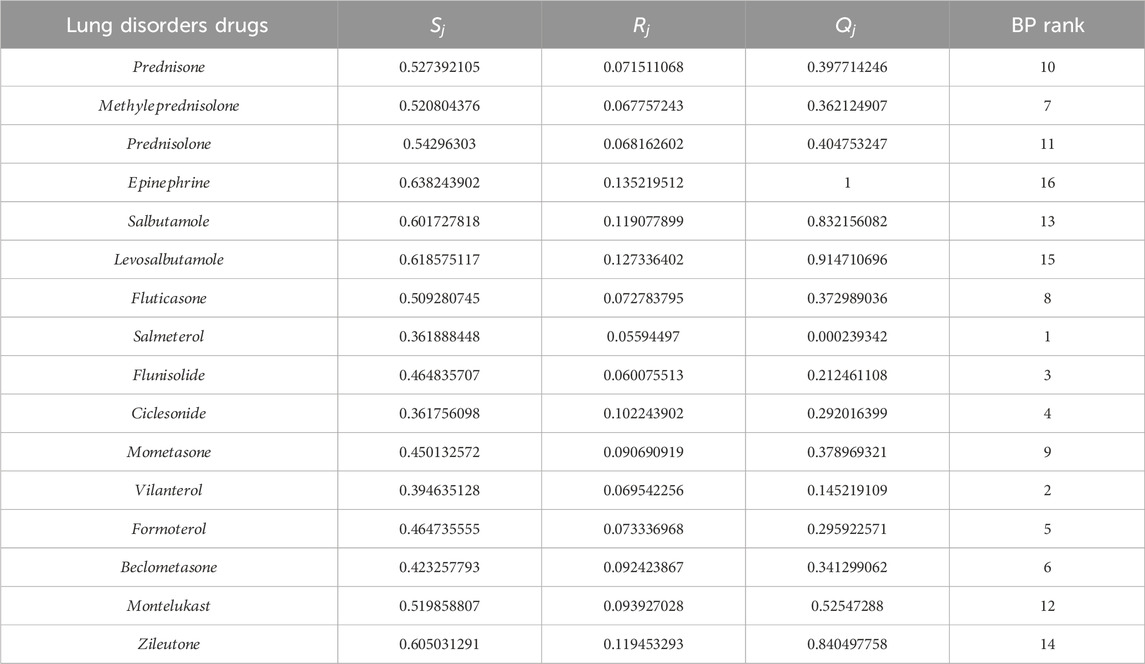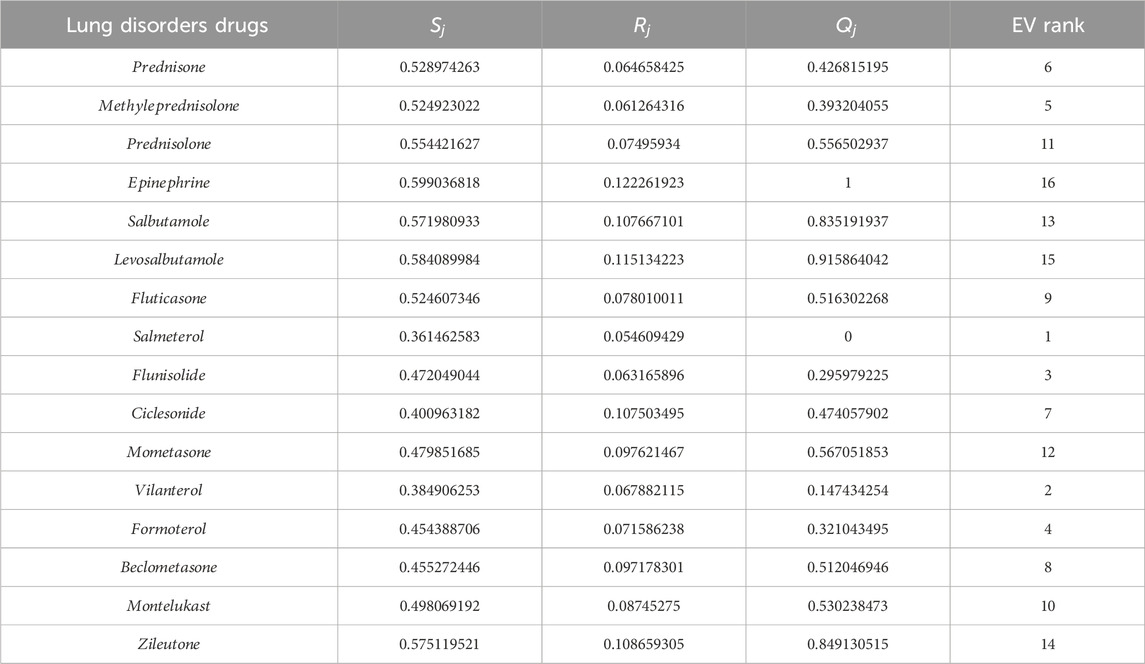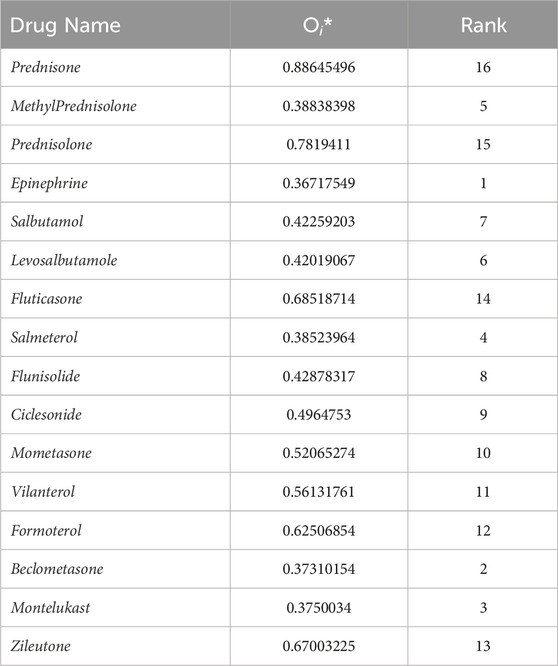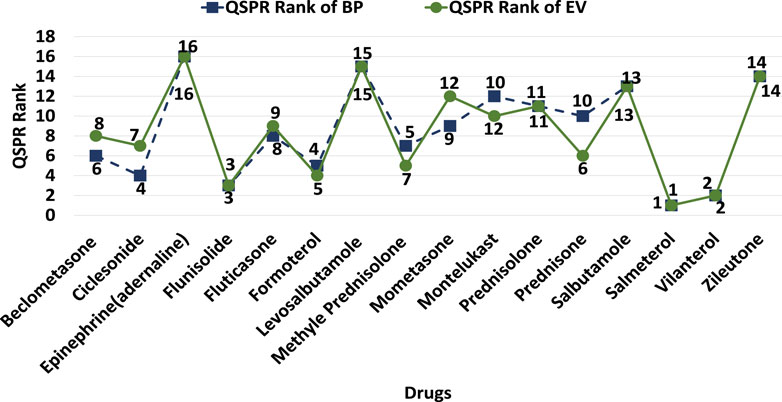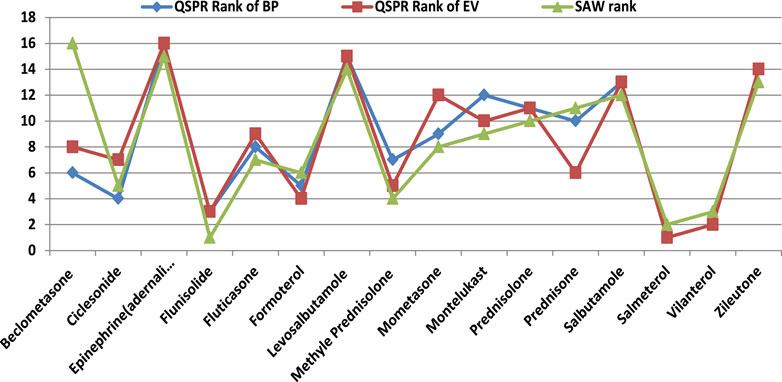- Department of Mathematics, Government College University, Faisalabad, Pakistan
Lung disorders involve swelling, inflammation, and muscle tightening around the airways, with symptoms such as coughing, wheezing, shortness of breath, and abnormal fluid build-up. The global prevalence of these conditions is rising, highlighting the need for extensive research to alleviate their severity and symptoms. Due to the chronic nature and recurrence of these disorders, the human body often develops immunity and side effects to certain medications. Therefore, developing novel and appropriate drug combinations is crucial. This study analyzes a dataset of lung disorder drugs, characterized by various topological indices. The structures of 16 drugs used to treat lung disorders are correlated with their physical properties using degree-based graph invariants. When considering specific attributes, the VIKOR (VlseKriterijumska Optimizacija I Kompromisno Resenje) method provides an optimal ranking for each drug. The QSPR results highlight the effectiveness of this approach in drug prioritization, offering valuable insights for clinical decision-making and drug development. This methodology can enhance the strategic selection of treatments for lung disorders, leading to improved patient care and better resource allocation.
1 Introduction
Human health is of utmost importance as it directly influences overall wellbeing and quality of life. Numerous diseases can significantly impact human health, and among these, lung disorders stand out as chronic respiratory conditions characterized by airway inflammation and bronchoconstriction. Over a quarter of a billion people worldwide suffer from lung disorders, making it the most common chronic illness in children. To address this condition, various drugs have been developed, including bronchodilators and anti-inflammatory agents, which help manage symptoms and reduce exacerbations. Recent advancements in medical research have utilized chemical graph theory to improve drug selection for lung disorder treatment, enabling a more precise and personalized approach to medication (Levy et al., 2023).
Chemical graph theory, at the intersection of chemistry and mathematics, employs graph theory principles to model molecules as graphs, with atoms as nodes and chemical bonds as edges. This approach enables the analysis of molecular structure, connectivity, and properties (Gutman et al., 2017). Recent applications include utilizing graph neural networks for molecular property prediction (Xiong et al., 2020) and investigating graph-theoretical descriptors for drug discovery and materials science (Lusci et al., 2013). A graph
Topological indices, essential in chemical graph theory, are numerical descriptors that encapsulate the structural details of molecules using graph-based representations (Yao et al., 2020). These indices, calculated from molecular graphs where atoms serve as nodes and bonds as edges, are crucial for predicting diverse chemical and biological properties (Todeschini et al., 2016). Recent research underscores their application in drug design, materials science, and environmental chemistry (Gao et al., 2021), demonstrating their ongoing importance in elucidating structure-property relationships in complex molecular systems.
Degree based topological indices have potential application in understanding the molecular basis of any drugs. Some latest research works has explored the use of topological indices in the prediction of allergenicity and lung disorders risk related drugs (Nandy et al., 2020; Zheng et al., 2021). They aid in optimizing molecular structures to enhance pharmacological activity and bio-availability (Gasteiger and Marsili, 1980). On the whole, topological indices are used as versatile tools with diverse applications, ranging from chemistry and drug design to network analysis and environmental studies. Recent studies have applied Quantitative Structure-Property Relationship (QPSR) approaches to predict lung disorders triggering potential and the toxicity of chemicals linked to lung disorders development (Kumar et al., 2021; Mukherjee et al., 2021).
Multi-Criteria Decision Making (MCDM) methods are increasingly relevant in the context of QPSR analysis for drugs-related research. Recent studies have employed MCDM techniques to weigh and prioritize multiple criteria or properties when evaluating the potential asthma triggering or therapeutic capabilities of chemical compounds (Oliveira et al., 2020; Zheng et al., 2021).
In the realm of MCDM, VlseKriterijumska Optimizacija I Kompromisno Resenje (VIKOR) has gained recent prominence as a valuable tool for addressing complex decision-making challenges. The VIKOR method depends on a compromise programming technique-derived aggregating function that symbolizes“closeness to the ideal”. Its application extends to various domains, including healthcare and environmental management (Ishizaka et al., 2021).
The VIKOR method, a Multi-Criteria Decision Making (MCDM) technique, offers several strengths and weaknesses. One of its primary strengths is its ability to identify a compromise solution that is closest to the ideal, balancing various conflicting criteria effectively. This makes it particularly useful in scenarios where decision-makers have differing preferences and objectives (Kuchta et al., 2020). Additionally, VIKOR’s flexibility allows for the adjustment of parameters to reflect the decision-makers’ preferences, making it widely applicable across diverse fields such as engineering, management, and healthcare. The method’s relatively straightforward computational process also enhances its accessibility and ease of use (Erdebilli et al., 2023). However, VIKOR also has notable weaknesses. The method’s results are highly sensitive to the weights assigned to different criteria, which can introduce subjectivity and potential bias if the weights are not accurately determined. Furthermore, VIKOR requires precise and accurate data for its analysis, which may not always be available or easy to measure, limiting its applicability in situations with uncertain or vague data (Arif et al., 2020).
Rest of the Paper: The rest of the paper is organized as follows. Section 2. Describes all the existing works related to this research work. In section 3., findings of topological indices and application of VIKOR is explained in detail. Section 4. Wraps up the discussion by summarizing the results and synthesizing the key points.
2 Existing works
In this section, we delve into the historical context and recent advancements associated with QSPR analysis, particularly its integration with chemical graph theory and the implementation of MCDM methods in factual scenarios.
Novel topological properties of chemical structures have found applications in the treatment of COVID-19 (Mondal et al., 2022). In another study, various molecular drug structures, including hyaluronic acid, an anticancer drug, polyomino chains of n-cycles are subjected to analysis using MCDM techniques like Technique for Order of Preference by Similarity to Ideal Solution (TOPSIS) and Simple Additive Weighting (SAW) (Zheng et al., 2019). Further investigations involve the exploration of topological indices associated with hyaluronic acid (Ravi and Desikan, 2023). Graph operations, specifically the double and strong double graph, are employed to derive closed formulas for certain degree-based topological indices of silicon carbide (Sardar et al., 2023). The Nirmala leap index and modified Nirmala leap index of some chemical drugs are considered against COVID-19 (Kumar et al., 2023). Additionally, the face index formula is computed for specific molecular structures within the benzenoid series, such as Polycyclic Aromatic Hydrocarbons (PAHs), jagged-rectangle benzenoid systems, and concealed non-kekulean benzenoid systems (Joita et al., 2023).
An array of QSPR analyses have been conducted, each targeting specific areas of pharmaceutical research. In one instance, an association between electronvolts (eV) and degree-based topological descriptors is established to predict the molecular weight and topological polar surface area of phytochemicals (Lubbad, 2009). Additional investigations encompass degree-based and neighborhood degree sum-based topological indices for anti-HIV drugs using M-polynomial formulations (Huilgol et al., 2022), degree-based topological indices and regression models for nine anti-malaria drugs (Zhang et al., 2022), and the computation of reformulated leap Zagreb indices, leap eccentric connectivity indices, and reformulated Zagreb connectivity indices for antiviral drugs (Ravi et al., 2023). Moreover, the physicochemical and pharmacokinetic properties like Absorption, Distribution, Metabolism, Excretion, and Toxicity (ADMET) of anti-flaviviral drugs are forecasted through a QSPR model based on multiple Revan indices (Tamilarasi and Balamurugan, 2023; Tayebi et al., 2023). The application of M-polynomial methods in QSPR analysis is extended to study various degree-based topological indices for headache drugs such as naproxen, flurbiprofen, fenoprofen, ketoprofen, and ibuprofen (Sardar and Ali, 2022), and to investigate the relationships between topological indices and physicochemical properties of blood cancer treatment drugs (Parveen et al., 2023). Thirteen degree-based topological indices for anticancer drugs are also subject to QSPR analysis (Shanmukha et al., 2020). Additionally, QSPR domination indices are leveraged to create robust models for predicting the physicochemical properties of organic compounds while maintaining symmetry (Wazzan and Ahmed, 2023). Lastly, statistical analysis is harnessed to predict the properties of antiviral drugs without the need for experimental trials (Sivakumar and Rajkumar, 2023).
In various decision-making scenarios, distinct methods are employed to address complex multi-criteria challenges. One such method is the Criteria Weight Average VIKOR (CWA-VIKOR), designed to handle uncertain fuzzy situations by considering criteria weight averages and hesitant fuzzy preference data (Wan et al., 2020). Another approach, the extended Dual Probabilistic Linguistic-vise-VIKOR (DPL-VIKOR) method, is proposed for addressing multi-criteria group decision-making problems in risk assessment, particularly in Technological Innovation Project (TIP) (Ashraf et al., 2023). To aid in selecting health insurance plans, a hybrid fuzzy MCDM method is recommended (Erdebilli et al., 2023). Additionally, a solution involving the integration of VIKOR with the Simple Multi-Attribute Rating Technique Exploiting Ranks (SMARTER) method is presented for prioritizing goods sellers in an e-marketplace within a MCDM framework (Arif et al., 2020; Wan et al., 2023). In the context of evaluating security policies and content analysis of press agencies in Gulf countries, a Fuzzy VIKOR approach is introduced as a valuable MCDM technique. This method incorporates linguistic variables to mitigate uncertainties and subjectivity in expert decision-making processes (Talib, 2020).
(Hui et al., 2023) used VIKOR, TOPSIS and COPRAS for comparative ranking of the nano-tubes while establishing a solid connection between topological indices and physiochemical properties of nano-tubes. Multiple linear regresion has been done of carbon, naphthalene, boron nitride, V-phenylene, and titania nanotubes (Zaman et al., 2023). made a QSPR model to predict the properties flash point, molar volume, boiling point, molecular wight and complexity and demonstrated that QSPR play important role in drug discovery (Bulut et al., 2024). study aimed to evaluate the data according to five accepted criteria for the effects of twenty promising anticancer agents and rationalizes decision making in a fuzzy environment to avoid the high cost and time requirements of further pre-clinical and clinical studies. Also, the results of inhibition against both cancer cells and bacterial strains were confirmed by molecular docking calculation sand the results obtained in cancer studies were evaluated with a multi-criteria decision making methodology (MCDM) (Aydın et al., 2021). (Özcan et al., 2020) considered the problem of selecting the most promising anticancer agents, showing inhibition at low
The authors have proposed a novel methodology to address these identified gaps, specifically applying QSPR analysis to investigate the characteristics of drugs for lung disorders. The primary contributions of this proposed work are summarized as follows:
3 Materials and methods
Lung diseases are characterized by inflammation and muscle constriction around the airways, manifests symptoms such as coughing, wheezing, shortness of breath, and chest tightness. Inhaled corticosteroids, Long-acting beta2 agonists, Leukotriene receptor antagonists and Leukotriene inhibitors the most effective long-term medications for asthma. These medications include Ciclesonide, Epinephrine (adrenaline), Flunisolide, Fluticasone, Formoterol, Levosalbutamole, Methyl Prednisolone, Mometasone, Montelukast, Prednisolone, Beclometasone, Prednisone, Salbutamole, Salmeterol, Vilanterol, and Zileutone (Falk et al., 2016). This study evaluates 16 drugs for lung disorders as shown in Figure 1.
The efficacy of asthma drugs is closely tied to their chemical compositions, which determine their mechanisms of action. Inhaled corticosteroids (ICS) like ciclesonide, flunisolide, fluticasone, beclometasone, and mometasone use fluorinated steroid structures to provide potent local anti-inflammatory effects with minimal systemic absorption, effectively controlling chronic symptoms (Nandy et al., 2020). Epinephrine, a non-selective catecholamine, offers rapid bronchodilation during acute attacks by activating both alpha and beta adrenergic receptors. Selective beta-2 adrenergic agonists, including short-acting salbutamol (albuterol) and levalbuterol, as well as long-acting formoterol, salmeterol, and vilanterol, relax bronchial smooth muscle to induce bronchodilation, with efficacy influenced by their chemical structures. Systemic corticosteroids like methylprednisolone, prednisolone, and prednisone provide potent anti-inflammatory effects crucial for severe exacerbations (Kumar et al., 2021). Montelukast and zileuton target leukotriene pathways to reduce bronchoconstriction and inflammation, effectively managing chronic asthma through their specific molecular configurations. Each drug’s unique composition underpins its efficacy, allowing for tailored asthma management that balances therapeutic benefits with side effects (Mukherjee et al., 2021).
Utilizing a MCDM approach for ranking based on QSPR analysis, the research emphasizes physical and structural properties, with a focus on boiling points (BPs) and enthalpy of vaporization (EV). Ratio weighting method (Odu, 2019) is used for weight allocation for the application of VIKOR that results in an optimal ranking for each lung disorders medication. Chemical indices used in QSPR modeling are detailed in Table 2 along with their formulas.
We have calculated the topological indices of a drug structure epinephrine
While using the formulas mentioned in Table 2.
All the remaining topological indices of each drug are calculated in similar way and numerical results of topological indices are mentioned in Table 3.
3.1 Correlation coefficient between physical properties and indices
We specifically examine the standard error (SE) and correlation coefficients
The proximity of the correlation coefficient
3.2 Weight allocation
This research focuses on categorizing drugs based on their physio-chemical properties, particularly by extracting QSPR data for EV and BPs. The study emphasizes that drug solubility plays a crucial role in their effectiveness, as more soluble drugs tend to be more potent. It also highlights the impact of endothermic substances on the dissolution process by absorbing heat during dis-solution. Lower melting and BPs are associated with greater positive effects for drugs, while high BPs can lead to reduced drug impact due to evaporation.
To facilitate this ranking, we designate the correlation coefficient as the weighting criterion. We have used ratio weighting method (Odu, 2019) for weight allocation using the formula
3.3 VIKOR technique
To achieve the best possible outcome close to the optimal result, we employ the VIKOR technique. In this approach, drugs treated as alternatives, are evaluated based on predefined criteria derived from the QSPR analysis conducted in the case study. VIKOR is used to rank these drugs and determine the compromise solution that comes closest to the ideal outcome. The concept of compromise solutions in MCDM was initially introduced by Zeleny (Sivakumar and Rajkumar, 2023) and Yu (Wan et al., 2020) in 1973, with practical applications identified in 1998 (Ashraf et al., 2023). The offered technique involves a series of steps outlined in Algorithm 1.If it is compared with other existing MCDM methods such as TOPSIS, which requires same number of properties and drugs for ranking drugs, the computational complexity increases (Hui et al., 2023) See Tables 6, 7.
Algorithm 1.VIKOR Technique.
1: Determination of ideal best
for all criterion functions which we considered as predicted properties.
2: Determination of the values of
3: Determination of values
whereas
4: Rank the alternatives, sorting by the values S,R and Q from the minimum value
3.4 Simple Additive Weighting (SAW)
SAW is a widely used multicriteria decision-making method that involves assigning weights to criteria and then summing up the weighted scores of alternatives to rank them (Zheng et al., 2019). Here’s how SAW works:
1. Normalization: The first step is to normalize the decision matrix, which contains the performance of each alternative across all criteria. Normalization ensures that all criteria are on the same scale and allows for fair comparison.
2. Weighting: Next, weights are assigned to each criterion to reflect their relative importance in the decision-making process. These weights can be determined based on the preferences of decision-makers, stakeholder consultations, or other methods such as the entropy method.
3. Scoring: Each alternative is scored on each criterion by multiplying its performance value by the corresponding weight. This results in a weighted score for each alternative on each criterion.
4. Aggregation: The weighted scores for each alternative are then aggregated by summing them up across all criteria. This results in a total score for each alternative.
5. Ranking: Finally, the alternatives are ranked based on their total scores, with higher scores indicating better performance. See Table 8.
SAW is straightforward and easy to implement, making it a popular choice for decision-making in various fields such as business, finance, and project management. However, it does not account for interactions between criteria and may not always produce the most optimal solution.
4 Conclusions and future directions
In this paper, 16 lung disorders drugs used in chemotherapy combinations were analyzed using VIKOR, a MCDM technique. The VIKOR analysis heavily relies on evaluations and considers two properties: BP and EV, in a QSPR modeling context. This approach is employed in drug research, focusing on two properties, i.e., BP and EV, significantly affecting drug absorption. In our QSPR analysis, we used correlation coefficients to relate individual properties to targeted degree-based chemical indices, along with error values from the evaluations. Degree-based chemical indices were chosen for their strong predictive capability.
We conducted evaluations using a decision-making technique to address this new research focus. The resulting rankings for 16 specific drugs based on their BP and EV are presented in Figure 4. These rankings provide valuable insights for scientists and chemists seeking to create effective drug combinations. Notably, eight out of the 16 lung disorders drugs achieved the same rankings in both the VIKOR process, considering BP and EV as provided in Table 7, 8, respectively. These drugs, along with their rankings, are as follows: Salmeterol (Rank 1), Vilantrol (Rank 2), Flunisolide (Rank 3), Prednisolone (Rank 11), Salbutamole (Rank 13), andZileutone (Rank 14), Levosalbutamole (Rank 15), and Epinephrine (Adrenaline) (Rank 16). This suggests that considering both BP and EV in the evaluation leads to equivalent rankings for these eight drugs.
Furthermore, SAW is employed and ranks obtained from this MCDM method are compared with VIKOR ranks in Figure 5.
This research aims to draw conclusions from the QSPR analysis regarding two physio-chemical properties, BP, and EV, with implications for drug development and solubility estimation in medicinal and environmental chemistry. It demonstrates how QSPR evaluations impact the ranking of multiple structures under various criteria. It’s essential to keep in account that the emphasis is not solely on chemical indices but also on how individual chemical indices contribute to achieving the best outcomes, offering insights for biologists and scientists to explore potential drug combinations. The proposed strategy of relating indices and properties can be employed for drug discovery and predicting properties.
Data availability statement
The original contributions presented in the study are included in the article/supplementary material, further inquiries can be directed to the corresponding author.
Author contributions
TA: Writing–original draft, Writing–review and editing, Conceptualization, Data curation, Formal Analysis, Funding acquisition, Investigation, Methodology, Resources, Software, Visualization. NI: Supervision, Project administration, Writing–review and editing.
Funding
The author(s) declare that no financial support was received for the research, authorship, and/or publication of this article.
Conflict of interest
The authors declare that the research was conducted in the absence of any commercial or financial relationships that could be construed as a potential conflict of interest.
Publisher’s note
All claims expressed in this article are solely those of the authors and do not necessarily represent those of their affiliated organizations, or those of the publisher, the editors and the reviewers. Any product that may be evaluated in this article, or claim that may be made by its manufacturer, is not guaranteed or endorsed by the publisher.
References
Arif, M., Suseno, J. E., and Isnanto, R. R. (2020). Multi-Criteria decision making with the VIKOR and SMARTER methods for optimal seller selection from several e-marketplaces. E3S Web Conf. 202, 14002. doi:10.1051/e3sconf/202020214002
Ashraf, S., Ijaz, M., Naeem, M., Abdullah, S., and Alphonse-Roger, L. B. (2023). Extended DPL-VIKOR method for risk assessment of technological innovation using dual probabilistic linguistic information. J. Math. 2023, 1–15. doi:10.1155/2023/7570984
Aydın, A., Ökten, S., Erkan, S., Bulut, M., Özcan, E., Tutar, A., et al. (2021). In–vitro anticancer and antibacterial activities of brominated indeno [1, 2-b] qinoline amines supported with molecular docking and MCDM. ChemistrySelect 6 (13), 3286–3295. doi:10.1002/slct.202004753
Bulut, M., Ökten, S., Özcan, E., and Eren, T. (2024). N-Function heterocycles as promising anticancer agents: a case study with a decision model in a fuzzy environment. Lett. Drug Des. Discov. 21 (1), 101–115. doi:10.2174/1570180819666220704110011
Erdebilli, B., Gecer, E., Yılmaz, İ., Aksoy, T., Hacıoglu, U., Dinçer, H., et al. (2023). Q-ROF fuzzy TOPSIS and VIKOR methods for the selection of sustainable private health insurance policies. Sustainability 15 (12), 9229. doi:10.3390/su15129229
Falk, N. P., Hughes, S. W., and Rodgers, B. C. (2016). Medications for chronic asthma. Am. Fam. Physician 94 (6), 454–462.
Gao, J., Zhan, Z., He, Y., Li, P., and Gao, Y. (2021). Prediction of aqueous solubility of drug-like molecules using topological and E-state indices. J. Mol. Liq. 333, 115976.
Gasteiger, J., and Marsili, M. (1980). Iterative partial equalization of orbital electronegativity—a rapid access to atomic charges. Tetrahedron 36 (22), 3219–3228. doi:10.1016/0040-4020(80)80168-2
Gutman, I., Furtula, B., and Ghorbani, M. (2017). Topological indices in chemical graph theory. Math. Chem. Monogr. 17, 1–382.
Hui, Z. H., Aslam, A., Kanwal, S., Saeed, S., and Sarwar, K. (2023). Implementing QSPR modeling via multiple linear regression analysis to operations research: a study toward nanotubes. Eur. Phys. J. Plus 138 (3), 200. doi:10.1140/epjp/s13360-023-03817-5
Huilgol, M. I., Sriram, V., and Balasubramanian, K. (2022). Structure–activity relations for antiepileptic drugs through omega polynomials and topological indices. Mol. Phys. 120 (3), e1987542. doi:10.1080/00268976.2021.1987542
Ishizaka, A., Nemery, P., De Cock, D., and Bragard, C. (2021). Integrating multi-criteria decision analysis and human factors analysis for the assessment of medical device risks. Saf. Sci. 141, 105253.
Joita, D. M., Tomescu, M. A., and Jäntschi, L. (2023). Counting polynomials in chemistry: past, present, and perspectives. Symmetry 15 (10), 1815. doi:10.3390/sym15101815
Kuchta, D., Medonos, S., Stojanović, J., and Stanujkić, D. (2020). A new approach to solving the problem of green supplier selection based on VIKOR method. Sustainability 12 (6), 2301.
Kumar, A., Khan, W., and Kumar, S. (2021). Application of computational tools in the prediction of allergenic potential of proteins for the exacerbation of asthma: a machine learning approach. J. Biomol. Struct. Dyn. 39 (14), 5154–5166.
Kumar, M. B., Kulli, V. R., and Cangul, I. N. (2023). Nirmala leap indices of some chemical drugs against Covid-19. J. Discrete Math. Its Appl. 8 (1), 13–21.
Levy, M. L., Bacharier, L. B., Bateman, E., Boulet, L. P., Brightling, C., Buhl, R., et al. (2023). Key recommendations for primary care from the 2022 Global Initiative for Asthma (GINA) update. npj Prim. Care Respir. Med. 33 (1), 7. doi:10.1038/s41533-023-00330-1
Li, Y., Aslam, A., Saeed, S., Zhang, G., and Kanwal, S. (2022). Targeting highly resisted anticancer drugs through topological descriptors using VIKOR multi-criteria decision analysis. Eur. Phys. J. Plus 137 (11), 1245. doi:10.1140/epjp/s13360-022-03469-x
Lubbad, S. (2009). Modeling directional interactions in classical molecular dynamics for geometrical aspects of nanostructures. Bergen, Norway: The University of Bergen.
Lusci, A., Pollastri, G., and Baldi, P. (2013). Deep architectures and deep learning in chemoinformatics: the prediction of aqueous solubility for drug-like molecules. J. Chem. Inf. Model. 53 (7), 1563–1575. doi:10.1021/ci400187y
Mondal, S., De, N., and Pal, A. (2022). Topological indices of some chemical structures applied for the treatment of COVID-19 patients. Polycycl. Aromat. Compd. 42 (4), 1220–1234. doi:10.1080/10406638.2020.1770306
Mukherjee, S., Saha, A., and Basak, S. C. (2021). Topological descriptors in QSAR studies for identifying potential asthma-causing agents: a review. Curr. Top. Med. Chem. 21 (28), 2537–2552.
Nandy, A., Basak, S. C., and Basak, S. (2020). QSAR models for predicting potential asthma-causing agents: an update. Expert Opin. Drug Metabolism Toxicol. 16 (11), 943–955.
Odu, G. O. (2019). Weighting methods for multi-criteria decision making technique. J. Appl. Sci. Environ. Manag. 23 (8), 1449–1457. doi:10.4314/jasem.v23i8.7
Oliveira, R. S., Oliveira, D. F. M., and Lima, J. S. (2020). A multi-criteria decision analysis model for selecting environmentally sustainable asthma interventions. Sustainability, 12(22), 9510.
Özcan, E., Ökten, S., and Eren, T. (2020). Decision making for promising quinoline-based anticancer agents through combined methodology. J. Biochem. Mol. Toxicol. 34 (9), e22522. doi:10.1002/jbt.22522
Parveen, S., Ul Hassan Awan, N., Bashir Farooq, F., and Hussain, S. (2023). Topological descriptors and QSPR models of drugs used in blood cancer. Punjab Univ. J. Math. 55 (1), 27–43. doi:10.52280/pujm.2023.550103
Ravi, V., Chidambaram, N., Çolakoğlu, Ö., Ahmed, H., Jaganathan, S., and Jaganathan, J. (2023). QSPR study and distance-based new topological descriptors of some drugs used in the COVID-19 treatment. J. Math. 2023, 1–15. doi:10.1155/2023/1187415
Ravi, V., and Desikan, K. (2023). Curvilinear regression analysis of benzenoid hydrocarbons and computation of some reduced reverse degree based topological indices for hyaluronic acid-paclitaxel conjugates. Sci. Rep. 13 (1), 3239. doi:10.1038/s41598-023-28416-3
Sardar, M. S., and Ali, M. A. (2022). Topological indices and QSPR/QSAR analysis of some drugs being investigated for the treatment of headaches. Authorea Prepr.
Sardar, M. S., Ali, M. A., Ashraf, F., and Cancan, M. (2023). On topological indices of double and strong double graph of silicon carbide Si2 C3-I [p, q]. Eurasian Chem. Commun. 5 (4), 37–49.
Shanmukha, M. C., Basavarajappa, N. S., Shilpa, K. C., and Usha, A. (2020). Degree-based topological indices on anticancer drugs with QSPR analysis. Heliyon 6 (6), e04235. doi:10.1016/j.heliyon.2020.e04235
Sivakumar, B., and Rajkumar, V. (2023). Qspr modelling of anti-viral drugs through topological descriptors. Preprint Repository Name [Research Square]. Available at: https://doi.org/10.21203/rs.3.rs-3242879/v1 (Accessed August 14, 2024).
Talib, A. M. (2020). Fuzzy VIKOR Approach to evaluate the information security policies and analyze the content of press agencies in gulf countries. J. Inf. Secur. 11 (4), 189–200. doi:10.4236/jis.2020.114013
Tamilarasi, W., and Balamurugan, B. J. (2023). QSPR model through revan indices to predict physicochemically and ADMET properties of anti-flaviviral drugs to treat zika virus. Biointerface Res. Appl. Chem. 13 (6)–556.
Tayebi, L., Rahimi, R., Akbarzadeh, A. R., and Maleki, A. (2023). A reliable QSPR model for predicting drug release rate from metal–organic frameworks: a simple and robust drug delivery approach. RSC Adv. 13 (35), 24617–24627. doi:10.1039/d3ra00070b
Todeschini, R., Consonni, V., Xiang, H., Holliday, J. D., Buscema, M., and Willett, P. (2016). Similarity coefficients for binary chemoinformatics data: overview and extended comparison using simulated and real data sets. J. Chem. Inf. Model. 56 (12), 2496–2512.
Wan, A. W. N. A., Zamri, N., Abas, S. S., Ismail, A., Tarmudi, Z., Naim, S., et al. (2023). An extended Interval Type-2 Fuzzy VIKOR technique with equitable linguistic scales and Z-Numbers for solving water security problems in Malaysia. Adv. Fuzzy Syst. 2023, 1–26. doi:10.1155/2023/9270880
Wan, S. P., Zou, W. C., Zhong, L. G., and Dong, J. Y. (2020). Some new information measures for hesitant fuzzy PROMETHEE method and application to green supplier selection. Soft Comput. 24, 9179–9203. doi:10.1007/s00500-019-04446-w
Wazzan, S., and Ahmed, H. (2023). Symmetry-adapted domination indices: the enhanced domination sigma index and its applications in QSPR studies of octane and its isomers. Symmetry 15 (6), 1202. doi:10.3390/sym15061202
Xiong, Z., Liu, X., and Qiu, X. (2020). Chemoinformatics approaches based on graph neural networks for drug discovery. J. Chem. Inf. Model. 60 (1), 52–65.
Yao, Y., He, J., Yang, K., and Zhao, J. (2020). Representation learning of molecular graphs with recurrent substructure pooling. J. Chem. Inf. Model. 60 (12), 5735–5745.
Zaman, S., Yaqoob, H. S. A., Ullah, A., and Sheikh, M. (2023). QSPR analysis of some novel drugs used in blood cancer treatment via degree based topological indices and regression models. Polycycl. Aromat. Compd. 44 (4), 2458–2474. doi:10.1080/10406638.2023.2217990
Zhang, X., Reddy, H. G., Usha, A., Shanmukha, M. C., Reza Farahani, M., and Alaeiyan, M. (2022). A study on anti-malaria drugs using degree-based topological indices through QSPR analysis. Math. Biosci. Eng. 20 (2), 3594–3609. doi:10.3934/mbe.2023167
Zheng, L., Wang, Y., and Gao, W. (2019). Topological indices of hyaluronic acid-paclitaxel conjugates’ molecular structure in cancer treatment. Open Chem. 17 (1), 81–87. doi:10.1515/chem-2019-0009
Keywords: topological indices, QSPR analysis, MCDM, lung disorders drugs, VIKOR
Citation: Ashraf T and Idrees N (2024) Topological indices based VIKOR assisted multi-criteria decision technique for lung disorders. Front. Chem. 12:1407911. doi: 10.3389/fchem.2024.1407911
Received: 28 March 2024; Accepted: 06 August 2024;
Published: 24 September 2024.
Edited by:
Hamed I. Ali, Texas A&M University, United StatesReviewed by:
Salih ÖKTEN, Kırıkkale University, TürkiyeAdnan Aslam, University of Engineering and Technology, Pakistan
Sobia Sultana, Imam Muhammad ibn Saud Islamic University, Saudi Arabia
Copyright © 2024 Ashraf and Idrees. This is an open-access article distributed under the terms of the Creative Commons Attribution License (CC BY). The use, distribution or reproduction in other forums is permitted, provided the original author(s) and the copyright owner(s) are credited and that the original publication in this journal is cited, in accordance with accepted academic practice. No use, distribution or reproduction is permitted which does not comply with these terms.
*Correspondence: Tahreem Ashraf, dGFocmVlbTEwMDRAZ21haWwuY29t
 Tahreem Ashraf
Tahreem Ashraf Nazeran Idrees
Nazeran Idrees